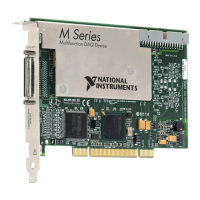© National Instruments | 10-3
M Series User Manual
• Programmed I/O—Programmed I/O is a data transfer mechanism where the user’s
program is responsible for transferring data. Each read or write call in the program initiates
the transfer of data. Programmed I/O is typically used in software-timed (on-demand)
operations. Refer to the Analog Output Data Generation Methods section of Chapter 5,
Analog Output, for more information.
Note USB Signal Stream channels are assigned to the first four
measurement/acquisition circuits that request one. When a USB Signal Stream is not
available, you must set the data transfer mechanism to programmed I/O; otherwise
the driver returns an error. To change your data transfer mechanism between USB
Signal Stream and programmed I/O, use the Data Transfer Mechanism property
node function in NI-DAQmx.
PXI Considerations
PXI clock and trigger signals are only available on PXI devices.
PXI Clock and Trigger Signals
Refer to the
PXI_CLK10, PXI Triggers, PXI_STAR Trigger, and PXI_STAR Filters sections of
Chapter 9,
Digital Routing and Clock Generation, for more information about PXI clock and
trigger signals.
PXI and PXI Express
NI PXI M Series devices can be installed in any PXI chassis and most slots of PXI Express
hybrid chassis. NI PXI Express M Series devices can be installed in any PXI Express slot in
PXI Express chassis.
PXI specifications are developed by the PXI System Alliance (
www.pxisa.org). Using the
terminology of the PXI specifications, some NI PXI M Series devices are 3U Hybrid
Slot-Compatible PXI-1 Peripheral Modules. Refer to your device specifications to see if your
PXI M Series device is hybrid slot-compatible.
3U designates devices that are 100 mm tall (as opposed to the taller 6U modules).

